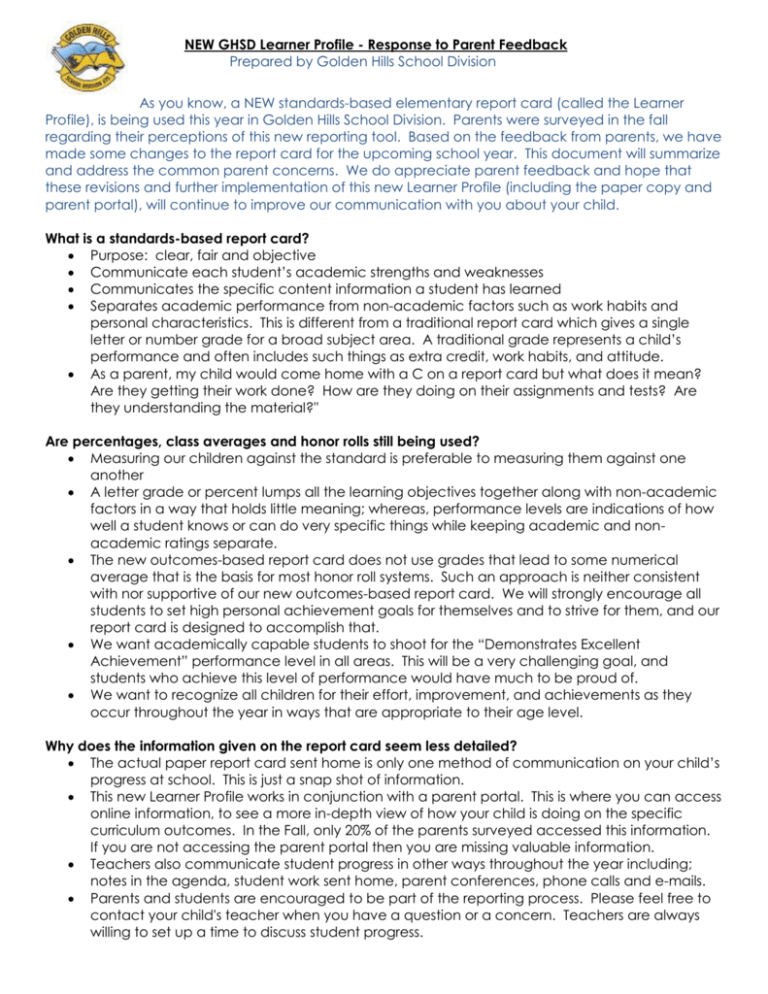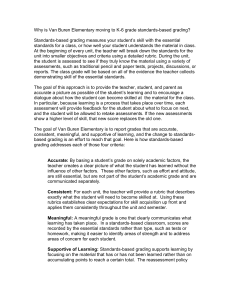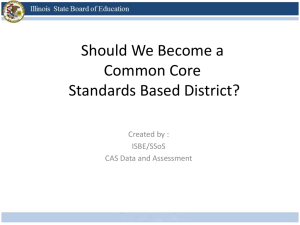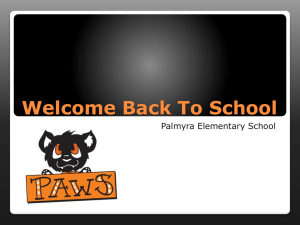Response to Parent Feedback - Step-By-Step
advertisement

NEW GHSD Learner Profile - Response to Parent Feedback Prepared by Golden Hills School Division As you know, a NEW standards-based elementary report card (called the Learner Profile), is being used this year in Golden Hills School Division. Parents were surveyed in the fall regarding their perceptions of this new reporting tool. Based on the feedback from parents, we have made some changes to the report card for the upcoming school year. This document will summarize and address the common parent concerns. We do appreciate parent feedback and hope that these revisions and further implementation of this new Learner Profile (including the paper copy and parent portal), will continue to improve our communication with you about your child. What is a standards-based report card? Purpose: clear, fair and objective Communicate each student’s academic strengths and weaknesses Communicates the specific content information a student has learned Separates academic performance from non-academic factors such as work habits and personal characteristics. This is different from a traditional report card which gives a single letter or number grade for a broad subject area. A traditional grade represents a child’s performance and often includes such things as extra credit, work habits, and attitude. As a parent, my child would come home with a C on a report card but what does it mean? Are they getting their work done? How are they doing on their assignments and tests? Are they understanding the material?" Are percentages, class averages and honor rolls still being used? Measuring our children against the standard is preferable to measuring them against one another A letter grade or percent lumps all the learning objectives together along with non-academic factors in a way that holds little meaning; whereas, performance levels are indications of how well a student knows or can do very specific things while keeping academic and nonacademic ratings separate. The new outcomes-based report card does not use grades that lead to some numerical average that is the basis for most honor roll systems. Such an approach is neither consistent with nor supportive of our new outcomes-based report card. We will strongly encourage all students to set high personal achievement goals for themselves and to strive for them, and our report card is designed to accomplish that. We want academically capable students to shoot for the “Demonstrates Excellent Achievement” performance level in all areas. This will be a very challenging goal, and students who achieve this level of performance would have much to be proud of. We want to recognize all children for their effort, improvement, and achievements as they occur throughout the year in ways that are appropriate to their age level. Why does the information given on the report card seem less detailed? The actual paper report card sent home is only one method of communication on your child’s progress at school. This is just a snap shot of information. This new Learner Profile works in conjunction with a parent portal. This is where you can access online information, to see a more in-depth view of how your child is doing on the specific curriculum outcomes. In the Fall, only 20% of the parents surveyed accessed this information. If you are not accessing the parent portal then you are missing valuable information. Teachers also communicate student progress in other ways throughout the year including; notes in the agenda, student work sent home, parent conferences, phone calls and e-mails. Parents and students are encouraged to be part of the reporting process. Please feel free to contact your child's teacher when you have a question or a concern. Teachers are always willing to set up a time to discuss student progress. Why did I have trouble accessing and understanding the parent portal? Administrators and teachers will continue to inform parents of the portal through school displays, websites, newsletters, e-mails, student agendas, and/or conversations. We have streamlined the process to make it easier to log in. The school requires an email address in order for you to self-register. Here is what we have done to make this easier for you to access. It now has fewer fields for you to fill in, please follow the steps below or click on this link for a demonstration video. Parent Portal Video Link. We would like more parents using this portal as there is other valuable information for you to view about your child’s learning. If at any time you have problem getting onto the parent portal, PLEASE contact your school secretary. Why is the highest Characteristics of a Successful Learner (CSL)-Indicators ‘Usually’? We will be adding a fourth indicator to the CSL component of student assessment: Rarely: Occasionally: Usually: Consistently: Is observed very infrequently Is observed some of the time Is observed a lot of the time Is observed most of the time *NEW in 2013-2014 Where do these “Learner Outcomes” come from? Alberta curriculum documents are set out by the government that outline what teachers must cover. Over the last few years, teachers in Golden Hills have worked from these documents, to identify the most important things students must know and be able to do at each grade level in each subject area. These essential benchmarks are identified on our report cards. How do teachers come up with my child’s mark? Teachers collect evidence of student achievement throughout the year and should be able to share this evidence with parents to support the evaluation. Your child will be assessed in a variety of ways. Evidence may include student products (such as projects, tests, and assignments), checklists of observations or documentation of communication interactions. There should be multiple opportunities for students to show what they know and are able to do in a variety of ways. CSL’s are rated on the qualities a student displays across all content areas and not just a single discipline. Ongoing observations take place daily in the classroom. Teachers may use assessment activities that cover multiple elements at one time and/or assess multiple children at one time. Student performance may be assessed during the course of regular classroom instruction and activities or by a specific assessment of the teacher’s choice. Several assessments over a period of time are the best way for a teacher to get a true picture of the range of what a student can do What are the benefits of standards-based report cards? Research shows that when students have a clear understanding of what the learning target is then student achievement increases. Reversely, poor grading practices can inhibit them from learning. The standards-based report card is helpful in multiple ways: o It makes sure that there is consistency of expectations from teacher to teacher and school to school. o It helps teachers and students focus on the learning outcomes, giving students a chance to get help sooner if they are not making adequate progress. o Parents will know which big ideas and concepts their child has learned and what their child needs to work on. There's widespread agreement among educators that the standards-based report cards are more informative than traditional ones, and that they're more accurate and informative. It is essential to move away from old and traditional grading methods that were developed and used for another time period of education. o Traditional grading is a system that is subjective. In older traditional grading systems, grades on report cards often cannot be clearly explained with the high level of consistency, reliability, and clarity that should be expected of a quality educational system that is standards-based.








